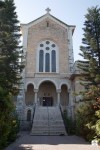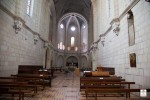Latrun (Latrun Monastery)
There are two theories about the origin of the name Latrun: one claims it is a distortion of the name of a Crusader castle that once stood here, Le Toron des Chevaliers – the tower of the knights; the other claims it is a distortion of the name it was called by Christian pilgrims, Castrum Boni Latronis – the home of the good thief (latro). According to Christian tradition the good thief crucified with Jesus and promised by him a place in heaven, came from here.
East of the Latrun junction is the Cistercian Abbey of the Trappist Order, built in 1890. The monks observe a vow of silence. They engage in viniculture and the production and sale of wine.
At the hill summit south of the monastery are ruins of the abandoned Arab village of Latrun, built on the site of the Crusader castle. North of the junction is a British Mandate Tegart police fort.
To the northwest, 3 km. (1.8 miles) from the junction, is Canada Park, opened in 1976. It contains: vineyards, almond orchards, ancient fig trees, ruins of ancient settlement of Emmaus and other antiquities and recreation facilities.
History: Latrun is located on a junction and therefore, it was always considered a key point for conquest and control of Jerusalem and it was an object of many battles in various periods. At the time of the Israelite conquest, Joshua defeated the Amorite kings in the adjacent- Ayyalon Valley (Josh. 10-11). In 166 BCE Judah Maccabee defeated the Greek general Gorgias in this area. During the Roman Period a number of Roman Legions encamped here. In the 7th century the Arab armies edmeds24.com a large military camp near Emmaus. The Crusaders built a castle here to protect the road to Jerusalem. In World War I the British captured Latrun and opened the way for the capture of the Holy City. Prisoner-of-war camps for German and Italian prisoners were set up here by the British during World War II. Two of these camps later served as internment camps for Jewish underground fighters arrested by the British before the establishment of the State. On Black Saturday in 1946 most of Palestine’s Jewish leaders were arrested and interned here
At outbreak of War of Independence, the Jordanian Arab Legion occupied the police fort and the military positions, thus blocking the road to Jerusalem. All Israeli attempts at a takeover to break the blockade failed and resulted in heavy casualties. The siege of Jerusalem was lifted only after an alternative southern route was found – the “Burma Road”.



